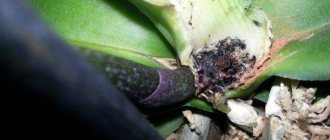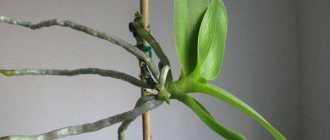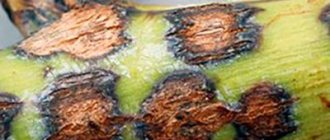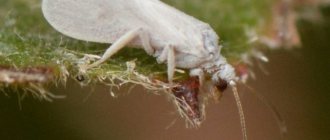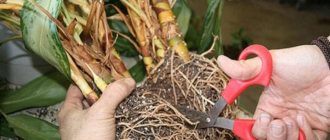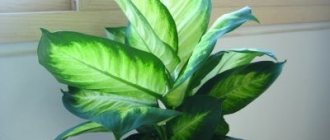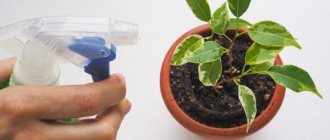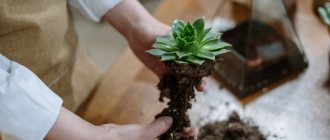Author: Elena N. https://floristics.info/ru/index.php?option=com_contact&view=contact&id=19 Category: Houseplants Published: August 6, 2012Republished: February 5, 2019Last edits: March 19, 2021
Caring for plants can bring both joy from the sight of beautiful and healthy flowers, and grief from failures: if a plant sheds its leaves, does not bloom, withers and dies before our eyes, inexperienced gardeners begin to panic, not knowing how to save their favorite flower. However, there are no hopeless situations; you just need to know where to look for a solution to the problem. In this article we will tell you about the symptoms of the most common plant diseases, as well as the causes of their occurrence.
Symptoms of plant diseases
Newly purchased plants are losing their leaves.
Plants, like people, can experience stress as a result of changes in their usual conditions, and the first sign of such stress is the loss of leaves by the plant. To minimize discomfort from moving, the plant must be wrapped when transporting in the winter season - protected from cold air.
The leaves fall instantly without losing color or turgor.
- Why can’t we get rid of late blight forever and what’s stopping this?
Most often, such consequences are caused by a sharp change in air temperature or cold drafts. Another reason may be a significant and sharp increase in the amount of light - the lighting intensity must be increased gradually.
Tree-like plants can suddenly lose their foliage if you allow the earthen clod to dry out too much.
The leaves turn yellow and then fall off.
Many plants begin to gradually shed their lower leaves over time - this is a normal biological process that does not require any action. If a plant drops several leaves at once, this is most likely caused by cold drafts or excessive soil moisture for a long time.
The leaves curl and fall off.
Often this symptom indicates that the room is not warm enough, or that the plant has been exposed to cold drafts, or that the soil in the pot does not have time to dry out between waterings.
The lower leaves dry out and fall off.
This may be a sign that the plant is not getting enough water. Another reason for the phenomenon may be too high an air temperature and lack of lighting.
The upper leaves turn yellow.
If the leaves turn yellow but do not wither, this is usually caused by the fact that too hard water is used for watering the plants (the water must sit for at least a day before watering). Another reason may be excess potassium in the soil, given that the plant does not tolerate lime.
The stems and leaves of the plant rot.
This is usually caused by water getting on the leaves or in the leaf rosette when indoor temperatures are low. In winter, the frequency of watering and spraying for almost all plants needs to be reduced.
Brown spots appear on the leaves.
- Anthracnose / Anthracnose
If the spots are dry, it is usually the result of insufficient watering. Keep in mind that almost all plants need to be watered immediately after the top layer of soil dries out.
If the spots are soft and damp, then this means that you overdid it with moisturizing.
Yellow or white spots on leaves.
Such spots may appear if the plant is exposed to direct sunlight for a long time (many plants cannot tolerate bright sun). Another reason: the plant is sick or damaged by pests. Spots also appear if the plant is watered with cold water or water gets on the leaves when watering.
The edges and/or tips of the leaves dry out and turn brown.
Most often this happens if the leaves constantly touch a wall, window or some other object. These changes are often caused by too dry air. Try to increase humidity by misting the plant or the air around it with water at room temperature.
Brown or yellow edges of leaves.
This disease is the result of a number of reasons. The edges of the leaves turn yellow or turn brown either from a lack of moisture in the soil or from its excess; due to dry indoor air; when overfeeding plants with mineral fertilizers; due to cold drafts. Such changes occur when the temperature regime is violated - the temperature is too high or too low than the plant needs. Another reason may be excessively strong or, conversely, insufficient lighting.
The leaves have drooped.
This is a symptom of a violation of the watering regime - both excess moisture in the roots and regular lack of it. Leaves may droop if the room temperature is higher than the plant needs and the lighting is too intense. Or if the pot is too small for the plant and the flower needs to be transplanted into a larger container. Other reasons: plant damage by pests or insufficiently high air humidity in the room.
The leaves are turning pale.
The plant may be affected by spider mites or suffer from too much light.
Holes and torn edges on leaves.
This is either pest damage or mechanical damage.
- Plaque on the leaves
Leaves become discolored.
Lack of light can cause plants with variegated leaves to lose their pattern and become monochromatic.
The stems stretch out, and new leaves grow small and pale.
The plant lacks minerals and needs feeding, or it lacks light. The plant also stretches out if it is not overwintered properly - too high a temperature in the room, unreasonably abundant watering and insufficient lighting.
The plant does not grow or grows slowly.
This is a normal phenomenon for the winter period, since winter is a dormant period for most indoor plants. If the plant is in a period of active growth, but does not develop, then the reason may be a lack of minerals. Development may stop due to the fact that the roots have filled the entire pot, and there is a need to replant the flower. Excess moisture in the soil and lack of lighting can also inhibit plant growth.
The buds are falling.
Bud drop is often caused by the same reasons as leaves drop. In addition, buds fall off due to insufficient soil and air moisture, from a sudden change in lighting, when attacked by pests, or from changing the location of the flowerpot at the time of budding.
Lack of flowering.
One of the main reasons that a plant does not bloom is improper care of it during the dormant period. The plant does not bloom if the air humidity is too low, if there is not enough light, or if too many minerals have accumulated in the soil. Some types of plants do not want to bloom in a spacious pot.
Short flowering.
Flowers can quickly fade from lack of water - from too infrequent or sparing watering, from insufficient air humidity, which can be increased by placing the pot on a tray with wet expanded clay, from heat or lack of light.
Plaque on a ceramic pot.
A green coating indicates excessive watering or poor drainage - the soil does not have time to dry out or excess water does not leave the pot.
A white coating appears when watering the soil with hard water (we remind you: the water must be left to settle for 24 hours before watering) or when over-fertilizing with mineral fertilizers.
You can fight all these troubles, but it’s easier to avoid mistakes in care by strictly following the rules for growing indoor plants. After all, it is easier to prevent a problem from occurring than to look for ways to eliminate it later.
Protection
Spots affect deciduous trees and shrubs of different ages, but they pose the greatest danger to young plants. It is necessary to protect plants in nurseries, young crops and urban plantings.
Basic measures to protect against spotting:
- systematic surveillance of the appearance and spread of spots from May to August;
- destruction of fallen leaves in the fall - the main source of infection;
- in case of mass lesions with spotting, repeating from year to year, spraying the crowns of trees and shrubs with fungicides starting from the moment the first spots appear on the leaves (the frequency of treatments depends on the biological characteristics of the pathogens and weather conditions).
_____________________________________________________________________
Black nemosporous necrosis of oak
This disease is spread by rain, wind and insects, causes white sapwood rot and can cause plant death within two to five years. This necrosis is dangerous primarily for young trees.
Scab, or blackening of willow shoots
It affects different types of willow: white willow (Salix alba), goat willow (Salix caprea), twig willow (Salix viminalis) and others, but most strongly - weeping forms.
Tags:birch, disease, hawthorn, elm, mushrooms, oak, willow, maple, linden, leaves, spotting, rowan, lilac, snowberry, poplar, ash
Should I trim off brown leaf tips?
Restoring watering schedules, humidifying the air, and repotting will help prevent brown leaf tips in the future. But what to do with the ones you already have? They will not recover, so it is better to cut them off with sharp scissors or special garden tools.
- 5 mistakes in caring for indoor plants for beginners. Confession of a careless florist
- Why plant leaves turn yellow - 9 common reasons. Indoor plants and plot
Subscribe to our YandexZen channel to find out more!
Insufficiently humid air
For indoor plants native to tropical countries, this is the main cause of brown leaf tips. For them, not only regular and abundant watering is important, but also humidity. The problem is especially acute in winter. Fortunately, it's not difficult to solve.
Spray the plant with a spray bottle every day. Fertilizers can be added to the liquid to simultaneously enhance growth or immunity. Another way to solve the humidity issue is to place containers of water next to the pots. You can avoid brown leaf tips by purchasing a humidifier for your home.
Irregular watering
For some indoor plants, proper watering is a fundamental issue. But brown leaf tips can also appear in unpretentious plants. This usually happens when the grower first overwaters the plant so that it drowns, and then barely drizzles the next time.
Houseplants, with the possible exception of succulents, require regular watering. Within one season, the amount of water and frequency of watering should remain constant. You can’t pour a lot once and not enough the second time, because the ground is not as dry as the last time. This will definitely result in brown leaf tips. Pour until water drips from the bottom. Always water at regular intervals.
